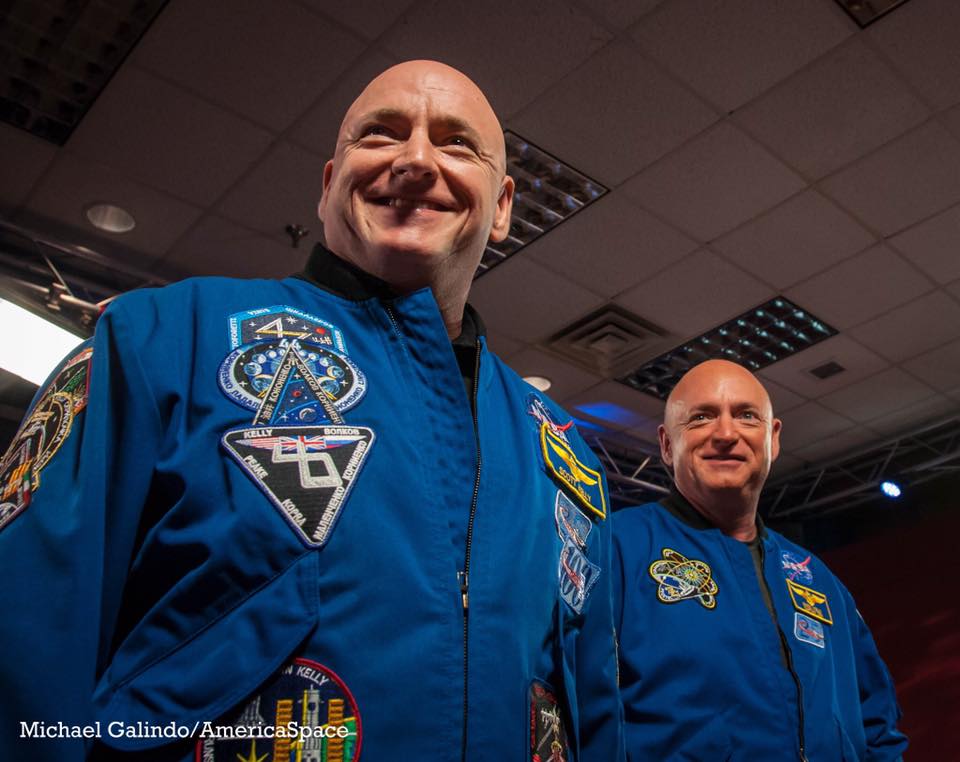
Despite fatigue, muscle soreness and—untouched by the full force of terrestrial gravity in almost a year—a peculiar “itchiness” of the skin, NASA astronaut Scott Kelly feels that his 340 days in space have cleared a significant psychological and physiological milestone towards someday planting boots on Mars. During press events at the Johnson Space Center (JSC) in Houston, Texas, last Friday, Kelly spoke candidly about his time in orbit, his spectacular #EarthArt imagery, his first impressions of the Home Planet upon returning to terra firma and his hopes for the future.
“I think the only big surprise was how long a year is,” Kelly began. “It seemed like I’d lived there forever; seemed longer than I thought it would be.” A veteran of three previous missions, including two short-duration shuttle flights and a 159-day International Space Station (ISS) increment between October 2010 and March 2011, Kelly had learned to pace himself appropriately during his early days and weeks in orbit. That said, he noted that working with a small group of other astronauts and cosmonauts in the relatively closed environment of the station was a testament to NASA’s and the International Partners’ ability to select compatible people. He also managed to draw deeply upon his U.S. Navy career experience by “compartmentalizing” his thinking during the long mission, in order to focus upon the tasks at hand.
Asked about his #EarthArt imagery, which included stunning photographic views of the Home Planet, including—the beautiful colors and textures of Africa—Kelly affirmed its central role in everything that makes us who we are. “It’s very important to our survival,” he said. “The space station is a great vantage point to observe it and to share our planet in pictures. You also notice how the atmosphere looks and how fragile it looks. It makes you more of an environmentalist, spending so much time looking down on it.” As to his future plans, he was non-committal about whether he will fly into space again, but highlighted a number of beautiful places on Earth, which he has either visited or hopes to visit. The Bahamas, he said, was a long-time favorite, but he also toyed with the possibility of visiting the remote, lake-studded region to the north of the glorious Himalaya, on the borderland of China and Tibet, which would offer challenge and difficulty to reach.
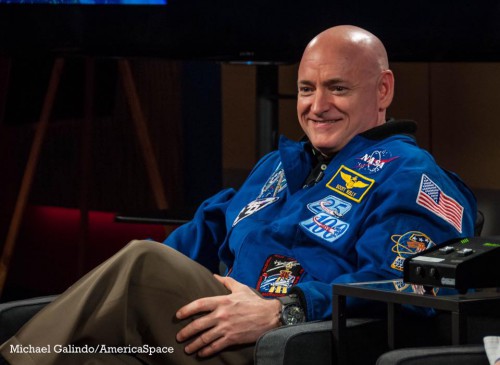
Having flown a long-duration mission previously, on Expeditions 25/26, as well as having served on the backup crew for Expedition 5, earlier in his NASA career, Kelly initially felt himself well-prepared for almost a full Earth-year in space. “Loneliness”, in the sense of succumbing to “the blues”, did not particularly manifest itself for Kelly, although it was natural for him to miss his family and friends and the beauties of Earth. He told the JSC audience that he took his mission one day at a time and set himself relatively close future milestones: the arrival of the next crew or unpiloted Visiting Vehicle (VV), for instance, or an upcoming EVA, robotics task or major science activity.
“I could have gone longer on this flight, if there was a good reason,” he said, alluding to the possibility of a vehicle launch delay—such as the unexpectedly prolonged Expedition 43 increment of Terry Virts, Anton Shkaplerov and Samantha Cristoforetti—although he expressed his belief that between 2.5 and three months is about an optimum duration for a long station flight. By this point, he already felt that he had been in space for a long time and the thought of a further nine months posed some difficulty. Returning from a year away from the Home Planet, Kelly’s prior experience taught him that his fatigue level might be heightened, but he did not anticipate the muscle soreness, joint pain and a strange itchiness of his skin which characterized his return from this mission.
“Initially, this time, coming out of the [Soyuz TMA-18M] capsule, I felt better than I did last time,” he replied to one questioner, “but at some point those two lines have crossed and my level of muscle soreness and fatigue is a lot higher than it was last time. It makes me think maybe there’s a linear function to it.” Kelly felt that the itchy, burning sensation was likely associated with his skin not having touched anything for a long period of time. Unsurprisingly, he was reluctant to comment on the effects of the mission upon his crewmate, Russia’s Mikhail Kornienko, although he was full of praise for the veteran cosmonaut, whom he described as a friend for life. It was not mandatory for two crew members to have been assigned to the (almost) year-long mission, but Kelly considered it “nice” to have had someone else progressing through the same increment profile with him.
The two men are, of course, the first people to have spent such an extreme amount of time in space in the 21st century—and the first to do so aboard the ISS—although missions of around a year have been done several times aboard the Mir space station. This orbital outpost was operated in the declining years of the Soviet era and the opening decade of the Russian Federation and saw no fewer than six cosmonauts fly missions of more than 300 days. Firstly, in December 1987, Yuri Romanenko chalked up 326 days, securing a new world record for the time, which was itself broken in December 1988, when Vladimir Titov and Musa Manarov came home after almost 366 days aloft. This was eclipsed in March 1995, when Valeri Polyakov completed a 437-day mission, which remains the longest single spaceflight ever undertaken in human history. Two others have completed impressive endurance missions, with Sergei Krikalev wrapping up a pair of back-to-back expeditions, totaling almost 312 days, between May 1991 and March 1992, and Sergei Avdeyev flying for 379 days between August 1998 and August 1999.
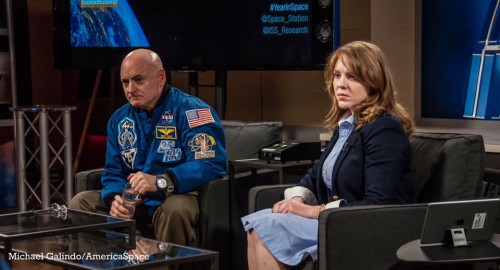
Conducted in a bygone era, these missions did not benefit from the advances in medical monitoring technology which accompanied Kelly and Kornienko. Yet each of them contributed significantly to our understanding of how the human body changes and adapts to the strange microgravity environment, as well as how it recovers upon a return to Earth. Moreover, the “interconnected” nature of Kelly’s increment—during which he benefited from continuous contact with Mission Control, the ability to phone and email his family and friends, as well as using Twitter—has substantially lessened the sense of psychological isolation that the cosmonauts may have experienced.
In the final months of Romanenko’s stay aboard Mir, for instance, the cosmonaut grew weary and was frequently awakened at night by the noise of the station’s air-circulation fans. When he grew more tired during the working day, he took medicine at night and reports in the Western press in the fall of 1987 suggested that his working day was reduced to 5.5 hours. This had dropped still further to 4.5 hours by December, a few weeks before his scheduled return to Earth, although Romanenko remained insistent upon running several miles daily on the station’s treadmill to prepare himself for the grueling onset of terrestrial gravity. When he finally came home, the cosmonaut was fatigued, homesick and—although able to sit upright in the recovery helicopter—sustained some leg muscle wastage. Nonetheless, he was able to walk unaided within hours of landing and completed a 330-foot (100-meter) run the next day.
Several years later, in March 1995, Valeri Polyakov wrapped up more than 437 days on a single mission. He did not appear to have suffered any significant problems during his stay in space and was able to walk from the Soyuz descent module over to the reclining chairs which were provided for transportation to a field hospital. Nor, indeed, did Vladimir Titov or Musa Manarov express any concerns when they returned from almost 366 days in December 1988. Their landing occurred under low clouds, thick fog and sub-zero temperatures, which meant the recovery helicopters took more than 30 minutes to find them. It gave them a period of quiet time to acclimatize to their new surroundings and to the onset of gravity.
Returning from his own long mission, Scott Kelly was privately surprised to see so many people in the same place after landing. He had, of course, been in contact with no more than eight other souls, simultaneously, during his stay aboard the ISS. Although he told Friday’s press conference that the “culture shock” had not yet hit him, he nevertheless expected to feel a substantial jolt of reality as he transitions from having so little around him in space to having so much around him on Earth. When the upper hatch of Soyuz TMA-18M’s descent module was opened, his senses were instantly overwhelmed by the sweet smell of home. This smell actually came not from blooming flowers on the desolate Kazakh steppe, but from the sweet, slightly sickly aroma of the charred surfaces of the Soyuz.
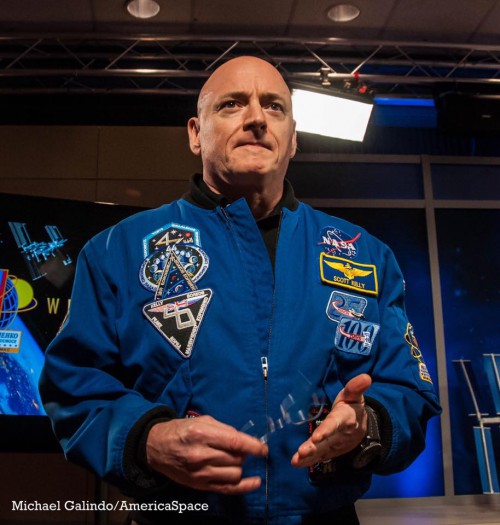
Kelly’s return from Kazakhstan to JSC in Houston followed a circuitous route, which took in refueling stops in Norway, where he submitted to some early medical tests, and then to Canada. The aircraft was originally scheduled to land at Canadian Forces Base (CFB) Goose Bay in Newfoundland and Labrador, Canada’s most easterly province, but bad weather obliged a diversion to Gander. Whilst in Canada, he managed to take a shower—and felt the sensation of running water on his skin for the first time in almost 12 months—which brought on the desire to jump directly into his swimming pool after his return to Houston. By his own admission, Kelly struggled to sleep on the aircraft, due to soreness and discomfort, and in the first few days since his triumphant homecoming to the United States he has undergone medical and physical tests, submitted to blood samples and MRI scans and performed functional fitness tests to complete tasks after a return from space.
And those tasks will have great significance in the future, as the men and women who follow Kelly embark on multi-month flights to Mars, after which they must extract themselves from their landing-craft and set up base camps in one of the most inhospitable environments ever visited by humans. Although he does not expect to fly into space with NASA again—there would be little reason for the space agency to use him again, with so many other qualified candidates in the Astronaut Office—Kelly feels that reaching the Red Planet, from a psychological and physiological perspective, is achievable, although important issues associated with radiation exposure during the outbound and return journeys, as well as the life-support and other technologies involved in the mission, remain to be resolved.
“When that Soyuz lands upright, you’re pretty much getting out of it yourself,” he replied to one audience question about the possibility of functioning on the surface of Mars, immediately after touching down. “I always had the assumption that someone would reach down and unstrap the commander and pull him out.” Not so; in the moments after hitting terra firma, cosmonaut Sergei Volkov—who commanded last week’s Soyuz TMA-18M landing and wrapped up his own 182-day stay aboard the ISS—unstrapped himself, opened the upper hatch and got himself partway out of the capsule, before recovery personnel pulled him out. As for Kelly, seated in the left-side “Flight Engineer-2” position, he had to unstrap, close the hatch, maneuver himself into Volkov’s center seat, then re-open the hatch and move halfway through in order to be pulled out.
During his long voyage, Kelly broke two U.S. records in space, passing Mike Fincke’s 381 days of cumulative experience and Mike Lopez-Alegria’s 215-day achievement for the longest single flight ever performed by an American. He also became the first NASA astronaut to command more than one ISS expedition and, on 21 January 2016, became the first U.S. citizen to pass 300 days in orbit on a single mission, before hitting a cumulative 500 days across his four-flight career on 10 February. However, he sees records as things to be broken. “I’m a big believer in pushing the envelope on this stuff,” he said, stressing that fellow astronaut Jeff Williams—who is due to launch towards the station aboard Soyuz TMA-20M on 18/19 March—will exceed Kelly’s cumulative record this summer.
Williams, who has already accrued 362 days in space across his three previous missions, should exceed Kelly’s 520-day U.S. cumulative record on 23/24 August, about two weeks before his own return to Earth. And there remains a possibility that former Chief Astronaut Peggy Whitson will extend this accomplishment still further, when she completes up a six-month stay aboard the ISS between November 2016 and May 2017. Added to her career total of 377 days, this could push Whitson in front of both Kelly and Williams, providing a clear indicator that the envelope will continue to be pushed into the final handful of years of planned ISS operations.
With thanks to AmericaSpace Photographer Michael Galindo, for the imagery associated with this article.
Be sure to “Like” AmericaSpace on Facebook and follow us on Twitter: @AmericaSpace
Missions » ISS » Missions » ISS » Soyuz TMA-M » Missions » ISS » Soyuz TMA-M » TMA-16M »



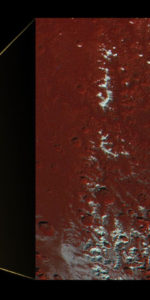
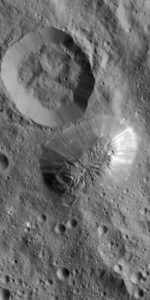
Scott made several interesting observations after his return. He likened his stay as camping in the woods for a year as well as cherishing running water and breathing fresh air. It is likely shared by others who experienced long duration missions and one has to wonder how humans will function for what could be a three-year trip away from home. It begs the question of whether advanced propulsion systems will be developed to shorten transit times to and from Mars. That, along with the multitude of other concerns such as radiation exposure. The mission will be accomplished and boots will be on Mars.